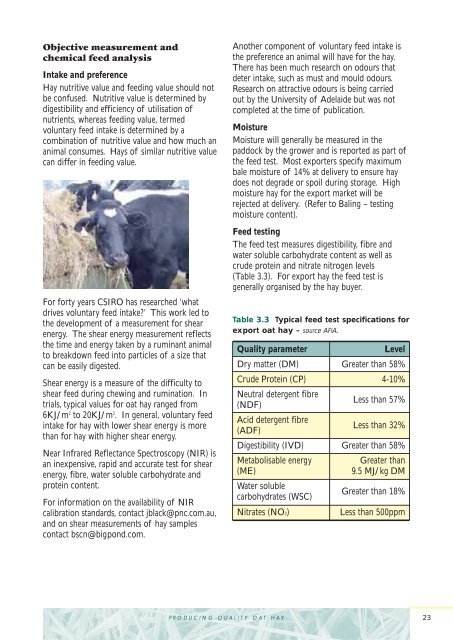You also want an ePaper? Increase the reach of your titles
YUMPU automatically turns print PDFs into web optimized ePapers that Google loves.
Objective measurement and<br />
chemical feed analysis<br />
Intake and preference<br />
<strong>Hay</strong> nutritive value and feeding value should not<br />
be confused. Nutritive value is determined by<br />
digestibility and efficiency of utilisation of<br />
nutrients, whereas feeding value, termed<br />
voluntary feed intake is determined by a<br />
combination of nutritive value and how much an<br />
animal consumes. <strong>Hay</strong>s of similar nutritive value<br />
can differ in feeding value.<br />
For forty years CSIRO has researched ‘what<br />
drives voluntary feed intake?’ This work led to<br />
the development of a measurement for shear<br />
energy. The shear energy measurement reflects<br />
the time and energy taken by a ruminant animal<br />
to breakdown feed into particles of a size that<br />
can be easily digested.<br />
Shear energy is a measure of the difficulty to<br />
shear feed during chewing and rumination. In<br />
trials, typical values for oat hay ranged from<br />
6KJ/m 2 to 20KJ/m 2 . In general, voluntary feed<br />
intake for hay with lower shear energy is more<br />
than for hay with higher shear energy.<br />
Near Infrared Reflectance Spectroscopy (NIR) is<br />
an inexpensive, rapid and accurate test for shear<br />
energy, fibre, water soluble carbohydrate and<br />
protein content.<br />
For information on the availability of NIR<br />
calibration standards, contact jblack@pnc.com.au,<br />
and on shear measurements of hay samples<br />
contact bscn@bigpond.com.<br />
PRODUCING QUALITY OAT HAY<br />
Another component of voluntary feed intake is<br />
the preference an animal will have for the hay.<br />
There has been much research on odours that<br />
deter intake, such as must and mould odours.<br />
Research on attractive odours is being carried<br />
out by the University of Adelaide but was not<br />
completed at the time of publication.<br />
Moisture<br />
Moisture will generally be measured in the<br />
paddock by the grower and is reported as part of<br />
the feed test. Most exporters specify maximum<br />
bale moisture of 14% at delivery to ensure hay<br />
does not degrade or spoil during storage. High<br />
moisture hay for the export market will be<br />
rejected at delivery. (Refer to Baling – testing<br />
moisture content).<br />
Feed testing<br />
The feed test measures digestibility, fibre and<br />
water soluble carbohydrate content as well as<br />
crude protein and nitrate nitrogen levels<br />
(Table 3.3). For export hay the feed test is<br />
generally organised by the hay buyer.<br />
Table 3.3 Typical feed test specifications for<br />
export oat hay – source AFIA.<br />
<strong>Quality</strong> parameter Level<br />
Dry matter (DM) Greater than 58%<br />
Crude Protein (CP) 4-10%<br />
Neutral detergent fibre<br />
(NDF)<br />
Less than 57%<br />
Acid detergent fibre<br />
(ADF)<br />
Less than 32%<br />
Digestibility (IVD) Greater than 58%<br />
Metabolisable energy Greater than<br />
(ME) 9.5 MJ/kg DM<br />
Water soluble<br />
carbohydrates (WSC)<br />
Greater than 18%<br />
Nitrates (NO3) Less than 500ppm<br />
23

















